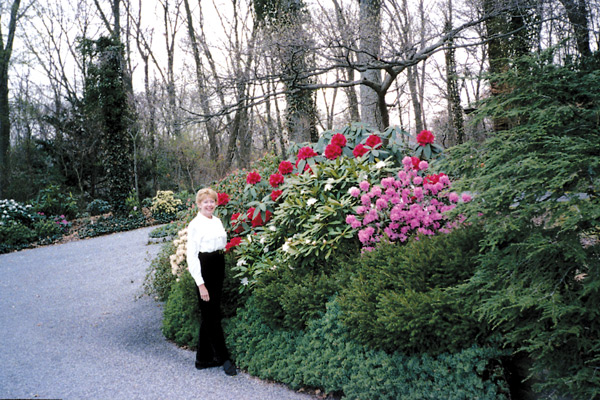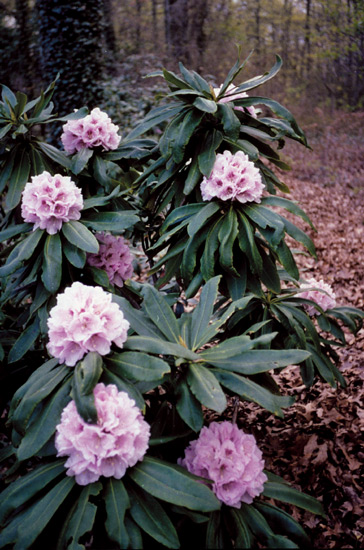Some Thoughts on Planting Elepidotes in Sunny Locations
Marianne and Bruce Feller
Old Field, New York
Although opinion sometimes varies among growers of rhododendrons with respect to the finer points of cultural requirements and preferences, we are largely of one mind in the East when it comes to the advantage of high canopy shade for elepidotes, particularly from afternoon sun. The absence of shade, however, need not preclude elepidotes altogether.
Open exposures present a combination of challenges:
Accelerated water loss
Higher ambient temperatures
Higher soil temperatures
Direct effects of full-day sun exposure on foliage and bloom
Accordingly, your strategy for sun tolerance needs to factor in all of these issues. Assuming the availability of irrigation, water loss can be addressed directly. Use of heavy mulches will also reduce evaporation and moderate soil temperature year round.
The issue of higher ambient temperature poses a more serious challenge. Perhaps the most heat tolerant rhododendron,
Rhododendron hyperythrum
, is part of the solution. This species has been used in hybridizing a number of heat tolerant offspring, including 'Hypermax', 'Charles Loomis' and 'Peppermint Twist'. Of course, don't overlook the obvious advantages of using deciduous azaleas as companion plants in open sunny settings.
Our own experience suggests that the most serious effects of direct summer sun on established rhododendrons is largely a much abbreviated bloom period - the flowers last only a day or so in hot weather before collapsing. While foliage can actually burn in periods of extreme heat and direct sun exposure this seems less a problem this time of year than the effect of summer sun on the flowers.

|
|
Marianne Feller and the red Rhododendron 'Taurus'.
Photo by Bruce Feller |
Bearing this in mind, consider planting very early blooming elepidotes in sunny locations. April bloomers are far less likely to encounter the high temperatures that quickly wilt flowers later in the season. You may want to try 'Taurus' or 'Grace Seabrook', two excellent early reds, and/or 'Babylon', a huge early white bloom with burgundy blotch. Other early blooming elepidotes include 'Bosutch', 'Christmas Cheer', 'Jacksonii', 'Spellbinder', 'Spring Glory', 'Strawberry and 'Pseudo Orange'. 'Hypermax', mentioned above, is also an early bloomer with the added advantage of R. hyperythrum parentage for basic heat tolerance.

|
|
Rhododendron 'Spellbinder'
Photo by Marianne Feller |
Strengthening the case for early bloomers are a number of other advantages. Their foliage develops and matures earlier, before the strongest periods of summer sun, and often before the host of chewing insects reach their destructive peak. They enjoy longer flower life, in sun or partial shade, and are rarely affected by petal blight as are later blooming varieties.
Our obvious affection for early blooming elepidotes is also based on the fact that they are unrivaled in the garden at that time of the year - when they can be most appreciated in the absence of competing influence at the very onset of spring bloom period.
Marianne and Bruce Feller are members of the New York Chapter and co-chairs of the Flower Show and Judging Advisory Resource.